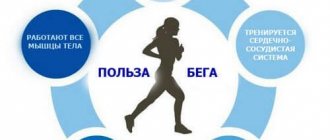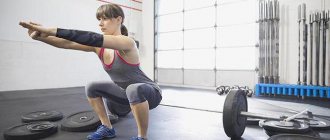The pulse during training is counted to determine the optimal load that has a training effect and does not overload the heart. When walking and exercising for health purposes, a heart rate of 50-60% of the maximum (220 minus age) is sufficient. When swimming long distances, maintain a heart rate of 60-70% of the maximum, when running and cycling it is optimal to exercise at 70-80%, and during strength training the heart rate increases to 80-90% of the maximum and higher in good physical shape.
It is equally important to determine whether the chosen training regimen is suitable. To do this, the morning resting heart rate is measured the next day, and its average values should decrease every month. A sign of good fitness is a pulse up to 75 beats/min, up to 90 is considered satisfactory, and at higher levels you need rest and reduced loads in the next lesson. After training with aerobic exercise (running, walking, cycling), the rhythm should be restored in 10-15 minutes, and after strength training - in 2-3 minutes.
Why is it important to know your heart rate during exercise?
Pulse during training is needed for:
- determining the optimal intensity of training;
- maximum efficient use of oxygen for energy production during aerobic exercise;
- choosing a load to develop endurance or muscle strength, burning fat, depending on the goal;
- prevention of overload of the cardiovascular system and complications (heart failure, arrhythmia, increased blood pressure, deterioration of coronary circulation).
Particular caution when training is necessary if you have heart disease. For such patients, it is necessary to select the load using an ECG with tests on a bicycle ergometer or treadmill.
Even those who have never exercised before should not try to immediately achieve maximum heart rate. Like any muscle in the body, the heart requires a period of entering the training regime. The duration of the preparatory period can be from 2-3 months to six months. At this time, only health-improving regimen is allowed.
With proper training, heart rate measurements are needed several times:
- before class;
- after warming up;
- upon completion of the main part;
- when the load decreases;
- after the cool-down at the end of the lesson.
Pulse is considered a much more objective criterion for the correctness of exercise than well-being.
How to calculate your target heart rate
First you need to determine your maximum heart rate and heart rate reserve. Since it is quite difficult to calculate the maximum heart rate during exercise, a simple formula is used for this:
220 - age = maximum heart rate.
220 - 28 years = 192 beats per minute.
Also, to calculate your target heart rate, you need to determine your heart rate reserve:
Maximum heart rate - resting heart rate = heart rate reserve. 192 beats per minute - 82 beats per minute = 110 beats per minute.
Before calculating the target zone, we provide a table of approximate intensity zones.
| Intensity zones | Intensity (% of maximum heart rate) |
| Recovery zone | 50–60% |
| Light Activity Zone | 60–70% |
| Aerobic zone | 70–80% |
| Anaerobic zone | 80–90% |
| Maximum effort | 90–100% |
Depending on what kind of workout you decide to do, take the percentage from the table and substitute it into the formula for calculating your target heart rate.
Resting heart rate + 70% heart rate reserve = target heart rate. 82 + (70% × 110) = 82 + 77 = 159 beats per minute.
That is, a pulse of at least 159 beats per minute will allow a 28-year-old person to remain in the aerobic zone.
Pulse during physical activity: normal, what is the maximum allowable
The pulse during physical activity is calculated based on the individual norm; the maximum allowable is approximately calculated as 220 minus age. For example, for a healthy 30-year-old man it will be 220-30 = 190 beats per minute. Only professional athletes train at this frequency. All others should build classes taking into account the type of load (see table).
| Type of training | Average pulse, beats/min. | Maximum heart rate, beats/min. |
| Running, swimming, skiing, dancing | 150 | 160 |
| Intervals with alternating running and strength training | 175 | 180 |
| Weightlifting, strength training | 175 | 185 |
At the athlete
For athletes, the resting heart rate is lower than for untrained people; it quickly rises to 80-95%, and this is considered normal; during intense exercise, the heart rate can increase to the maximum possible. The type of training also matters. It has been proven that runners who develop endurance to the lack of oxygen during exercise have a less frequent pulse during exercise than strength athletes and weightlifters.
In professional sports medicine, it is not the pulse during training that is used, but the initial values at rest and before the next load. They are the ones needed to assess the sufficiency of physical activity in well-trained athletes, since at maximum intensity they all show no less than 95-98% of the limit value.
Resting heart rate
Heart rate (HR) during the resting period reflects the degree of recovery of the cardiovascular system. In order to measure it, you need to count and record your pulse in the morning, immediately after waking up, while lying down. They keep a diary of their well-being, where they enter indicators and their feelings the next day after training. Then, for clarity, the data for the month is summed up and divided by the number of records. As a result, the average resting heart rate will be determined. For example, a diary might look like this:
- first month of classes – 68;
- second month – 67;
- third month – 65;
- fourth month – 67 (against the background of a viral infection);
- fifth month – 64.
If your heart rate slows down every month, this means well-chosen training. If your heart rate remains unchanged or increases, you must undergo a cardiac examination.
During strength training
Strength training has a higher heart rate than running or walking. After intense exercise, heart rate increases to 90% of the maximum, but this frequency is only suitable for a completely healthy person. When there is no good preparation, or there was a long break, or illnesses were suffered, then there is no need to increase the heart rate above 85%. If a man is 45 years old, then the acceptable limit is 85% of the maximum (220-45 = 175), which is 149 beats per minute.
It is very important to wait until your heart rate returns before your next approach. It returns to levels up to 90-100 beats/min. There should be no shortness of breath, palpitations, pain, or discomfort in the heart area. If the pulse does not decrease in 5-7 minutes, then this means that the load was incorrectly selected; it needs to be reduced in the next cycle. If you train with a constantly high heart rate, this can cause a malnutrition of the myocardium.
When swimming
Pulse when swimming long distances is calculated using the formula 60-70% of the maximum. For example, for a 40-year-old woman, the maximum number of beats per minute is 180. Then 60% will be 108, and 70% will be 126. Thus, you need to strive for a pulse interval of 110-125 beats/min. If swimming is carried out over short distances, then a gradual increase to 80% is allowed, but only with good load tolerance.
When walking
Walking is the optimal way to train for untrained people with heart disease; it is good to use for warming up; the recommended heart rate is 50-60% of the maximum. For example, for a 50-year-old man, you need to maintain your heart rate in the range of 85-102 (calculation: 220-50 = 170, 50% is 85, and 60% is 102).
For men and women running
Running for men and women is good for strengthening the heart muscle; to begin with, use a leisurely run, during which it is easy to carry on a conversation, and the heart rate should not exceed 70-80% of the maximum values. For a young man of 20 years old, the maximum heart rate will be 220-20 = 200 beats, so 70% is 140, and 80% is 160 beats/min. Training with a heart rate of 140-160 beats will be effective.
When riding a bicycle
When cycling, for a general healing effect, the heart rate rises to 60-70% of the maximum. This heart rate is used to restore the body after heavy loads; it can be alternated with an active training regime within 70-80%.
If the entire workout is within 75% of the maximum, then endurance increases, excess fat is burned, and at the same time muscle strength is strengthened. You can move to the zone with a heart rate of 80-90% of the maximum (220-age) and higher for no more than a minute.
During interval training in the gym
Interval training in the gym can be built according to a plan for alternating pulse zones, then during cardio exercise (for example, an exercise bike or treadmill), the pulse is 70-80% of the maximum, and during strength training (with weights) it reaches 80-90%. It is important that there are breaks between approaches when the heart rate is restored to 90-100 beats per minute.
What are heart rate zones, how to recognize them and why it is needed. We explain with frivolous examples
There are also many myths in it, starting with the well-known formula “heart rate max = 220 minus age” and ending with certain heart rate values at which running is especially harmful/beneficial (spoiler: everything is individual).
To shed some light on this topic for ourselves and you, we went to the VO2max Lab. There they put a mask on Pasha, put him on the track and forced him to take a treadmill test (guess his MPC).
At the same time, we asked Vladimir Tkachenko, a specialist in functional training and testing of athletes, about what all these heart rate zones mean and how to use knowledge about them in training.
Non-serious examples are in italics.
Let's understand the terminology: what is the difference between heart rate (HR) and pulse?
Pulse is the vibration when the heart beats, which causes the walls of blood vessels to vibrate. And heart rate is the number of contractions that the heart makes per minute.
These indicators belong to completely different categories. In our “running” case, it is correct to use the term “heart rate”. It is this physiological indicator that characterizes the work of the heart and the level of intensity of the load.
What are heart rate zones? Why know them?
A heart rate zone is a range of heart rate values that corresponds to a certain load intensity. At each intensity level, specific physiological changes occur in the body: for example, whether slow or fast fibers work predominantly, whether acidification occurs or not, etc.
Training in each heart rate zone helps develop appropriate adaptations in the body.
The principle here is simple: what we train is what we train.
Knowing our zones, we can specifically “pump up” weak points and build the training process more effectively, accurately dosing the intensity - so as not to overwork, but also not to “freeze”.
For example, a common mistake is to run recovery workouts too fast because it seems easy. Instead of recovery, improved fat utilization and other beneficial adaptations, the result is “neither this nor that” intensity and wasted training time of dubious benefit.
Knowing your heart rate range for the first zone, you can no longer focus on sensations (which often deceive), but on the readings of the heart rate monitor. That is, work clearly on the goal of this training, and not on what will work.
Heart rate zones are strictly individual for each person.
If you run by feeling or by “average” zones calculated using standard formulas (they can be found in almost any article on the topic), then there is a high chance of not guessing. At best, this will lead to you training in a suboptimal way - wasting a lot of time without much progress, at worst - you can even harm yourself.
What are the zones and what happens in the body when working in each of them?
The most rational method today is considered to be a method of dividing into pulse zones, taking into account critical points - aerobic threshold (AT), anaerobic metabolism threshold (ANT) and maximum oxygen consumption (MOC).
Threshold is the heart rate or intensity at which the body switches to another operating mode. The functioning of the body before and after thresholds is very different, and the training effect that we get largely depends on these differences. It will be fundamentally different at heart rate below and above the threshold, while the heart rate itself may differ by only a few beats.
The aerobic threshold (also called the ventilatory threshold or the first threshold) is the intensity of the load, above which anaerobic glycolysis is activated to provide the muscles with energy. Anaerobic means without the participation of oxygen.
That is, while we work at an intensity below AP, the body “produces” energy only through aerobic processes - with the participation of oxygen in the reaction. There are two of these processes:
- aerobic glycolysis (breakdown of glycogen to ATP)
- lipolysis (breakdown of fatty acids)
The more oxygen the muscles can use, the more fuel we can burn and the more energy we can get to do the work of moving the body per unit of time. Simply put, we will be able to run faster at any distance except sprint distances (100–200 m), since at them aerobic processes do not have time to be sufficiently involved in the work.
Lactic acid, a by-product of anaerobic glycolysis, is not released in aerobic mode, and acidification does not occur.
One of the main indicators of the aerobic threshold is the increase in ventilation. This is where we usually start breathing through our mouths instead of just our noses.
The first zone is intensity below the aerobic threshold. This zone is also considered a recovery zone.
Sometimes it is divided into two: first and second. This is usually done in cases where the aerobic threshold is high in speed, and with a load closer to AP, background stress already occurs in the body, and the recovery effect decreases.
What does working in the first zone give us:
- we learn to run more economically. There is no stress during such a load, but how long it will last is unknown, so the body trains to switch from the predominant use of carbohydrates to the use of fats. That is, lipolysis begins to prevail over glycolysis. This is good, because by using more fat, we save valuable glycogen and it will last longer. For example, during a marathon there will be less chance of hitting a carbohydrate “wall”.
- Due to the increase in lipolysis, the maximum oxygen consumption (MOC) also increases, since more oxygen is needed to obtain energy from fats.
- vascularization of the myocardium and muscles occurs - they are “overgrown” with a large number of capillaries. The more capillaries, the better the blood supply to the muscles.
- we recover faster after competitions or hard training. At this intensity, lactic acid is not formed, and its residues in the muscles after heavy exercise are actively released into the blood, accelerating recovery.
Let's try it with an example. We have a motor boat. The faster it swims (or do boats move too?), the more likely it is that a leak will open, and the faster water will get inside.
Supplies on the boat include canned food (fat) and Snickers (glycogen). Canned food tastes disgusting and is inconvenient to eat, but there is a lot of it. Snickers are tasty, easy and quick to eat, but compared to canned food, their supply is small.
We begin to swim slowly (first zone). At this speed, there is no leakage (lactic acid is not released), and there is no strain (acidification does not occur). There is nothing special to do, except perhaps improve something on the boat (capillaries, etc.).
You can swim like this for a very long time - the main thing is not to get hungry. If we don’t have enough experience, then the first thing we do is eat Snickers, and only then, when it’s time, we start choking on canned food. We don’t yet know that it’s better to save Snickers for when you don’t have time or it’s hard to deal with canned goods.
But after just a few trips to sea, the canned food seems to taste quite good, and we are in no hurry to throw in all the Snickers at once - let at least some remain in the stash (adaptation to fat metabolism occurs, lipolysis begins to prevail over glycolysis).
Let's speed up. And then there comes a moment when a leak forms and water begins to get inside the boat (lactic acid is formed). This moment is an aerobic threshold, after crossing which we swim to the second zone.
The second zone (or third, if the first is divided into two, as is often done) begins immediately after the aerobic threshold and ends with the anaerobic metabolic threshold (ANT). This is the so-called zone of development of general endurance.
As soon as we accelerate (add intensity) and pass the aerobic threshold, the level of stress stimulates the activation of anaerobic glycolysis - glucose is still broken down into ATP, but without the participation of oxygen. Then the body works in a “mixed” mode - aerobic-anaerobic.
In this zone, three energy supply mechanisms are already in use:
- aerobic glycolysis
- lipolysis
- anaerobic glycolysis
Also, as a result of anaerobic glycolysis, its by-product is produced - lactic acid, which enters the blood in the form of lactate. But the concentration of lactate in the blood does not change much, fluctuating between 2–4 mmol/l.
This happens because the buffer systems, which are responsible for normalizing the acid-base balance, still cope with their task quite well at such intensity. They are already working, but not at full capacity.
What does working in the second zone give us?
In short: a little bit of everything and nothing specific. Intensity training between AP and PANO can be useful in the preparatory period, for maintaining shape, for performing exercises from sports that help to actively take a break from running (biking, skiing, skating, rollerblading, etc.).
Work in the second zone is considered “supportive” and not effective. Four main processes are involved here at once, but none of them works at maximum and does not take over the entire adaptation resource. Thus, the training effect is dissipated by various factors, and in total it turns out to be small.
So, our boat is already sailing faster, in the second zone. There is a small leak (anaerobic glycolysis is activated), but water (lactic acid) is still flowing very slowly. We take a ladle (buffer system) and, without straining too much, scoop it out. Sometimes we are distracted by something to eat - Snickers or canned food.
We spread ourselves thin on different tasks and therefore don’t really learn anything: neither to savor canned food, nor to work more productively with a ladle. But in general, it’s normal here and you can swim.
We accelerate further, the flow intensifies, welcome to the third zone.
The third zone , or the zone of development of special endurance, is located at the level of the anaerobic threshold.
The anaerobic threshold (PANO, also known as the threshold of anaerobic metabolism, the second threshold, the lactate threshold, the Conconi point) is the “extreme” intensity of the load at which lactic acid is produced at the same speed with which buffer systems operating at maximum manage to neutralize it.
After undergoing PANO, they can no longer cope, the pH (acid-base balance) begins to decrease, and acidification occurs.
The third zone is usually the “narrowest”, with a small range of heart rate (about 5 beats/min). Under loads of this intensity, the power of buffer systems is maximum, and aerobic mechanisms work as efficiently as possible. There is the main factor here that takes on all the stress, so the body invests its main resource in improving the buffer system - learning to cope with high acidification.
What does working in the third zone give us?
The more you train in this zone, the more powerful your buffer systems become and the higher your anaerobic threshold. Amateur runners often have a large margin of PARP relative to VO2 max - in this case, training in the PAPC zone can significantly improve results, especially in the half marathon and marathon.
The peculiarity of the third zone is that this is a very narrow “corridor” of heart rate, and if you do not fall into it, but train with a heart rate even 2-3 beats higher or lower than this intensity level, then the effect will be fundamentally different, corresponding to the 2nd and 4 zones.
We settled on the fact that the leak had gotten worse, and we had to work with the ladle more vigorously. And at some point, the water comes in exactly as much as we manage to scoop out, trying our best (the buffer system works at maximum). This is PANO.
As soon as we accelerate a little more and pass this point, water will begin to accumulate (acidification) - the bucket (buffer system) will no longer cope. And this will begin the setup of the fourth zone.
In the third zone we only have time to refresh ourselves with Snickers (and they will soon run out, ahh!), unless the most omnivores manage to munch on a can or two.
What can you upgrade here? Of course, the ability to effectively use a ladle! For example, you can hold it more comfortably, move faster, work more rhythmically. And also, the next time you go out to sea, you will most likely take not a ladle, but a whole bucket (the buffer system will become more powerful).
The fourth zone , or the zone of development of anaerobic power, is located above the ANNO. The most powerful factor here is the rapid increase in lactic acid production and, as a result, acidosis.
Acidosis is an acidification of the body, in which the acid-base balance shifts to the acidic side and the pH decreases. While running, this manifests itself in the form of muscle pain, rapid breathing, and if you are patient enough to continue, in the form of vomiting, loss of orientation, and even, in especially severe cases, damage to muscles and organs.
The efficiency of aerobic mechanisms in this zone decreases (but can improve in rare cases, this is individual), and the entire adaptive potential is spent on resisting acidosis. The body has to rearrange protein structures to function in more acidic conditions, over a wider pH range.
What does working in the fourth zone give us?
By training at this level of intensity, we improve the body's ability to resist acidification. For example, to run faster in middle distances or to make a beautiful finishing acceleration in long distances.
In the fourth zone, our boat is sinking, and the end is inevitable. We don’t have time to scoop out the water with a ladle, and it becomes more and more. The only thing we can do here is to learn to sink more slowly (increase our resistance to acidosis). For example, throwing all things out of the boat.
If you accelerate too often and swim into this zone, spending a lot of time in it, then there is a risk of losing what you learned in the first zone, overheating the engine and even damaging the design of the boat.
Only rare, super-stubborn captains are capable of drowning with the boat (damage to organs) at full speed. The rest will slow down significantly or stop in order to somehow cope with the accumulated water. Because drowning is painful, and everyone is entitled to only one floating device and cannot be replaced.
What is maximum oxygen consumption?
MIC (aka VO2max) is the body’s maximum ability to obtain energy in efficient ways (without the release of lactic acid), that is, through aerobic glycolysis and lipolysis.
VO2max quantifies the capacity of a person's aerobic systems. The higher your intake, the more energy your body can produce aerobically, the more power your muscles can develop, and the more speed you can maintain.
Absolute MIC is measured in liters per minute, relative - in milliliters per minute per kilogram of mass. The absolute indicator is more important for short and medium distances, the relative indicator for long and extra-long distances with relief.
In medicine, MIC is used as one of the indicators of health level. Here are the standards for doctors:
Chances are, if you've been running regularly for a year or more, your VO2 max is in the excellent to excellent range. But this is from a medical point of view, and sports physiology has its own view.
Sports physiologists view VO2 max as a predictor of your level of performance in your chosen sport. That is, in fact, VO2max determines your talent and development potential in running.
For example, in professional track and field athletes, VO2 max is typically above 70 ml/kg/min. Amateur athletes have 40–55. Above 55 is the level of strong amateurs, at which you can already compete for prizes at amateur competitions.
The BMD indicator is largely determined by genetic data. It also depends on your training, but only until you get closer to your upper limit, which is included in your “firmware”. This individual “ceiling” of the IPC is fixed quite rigidly and it is almost impossible to break through it without using doping.
Let's return to the example with our boat. Some people got a pleasure boat with a dead engine, while others got a powerful speed boat. Randomly (genes are not selected).
Each boat comes with a set of tuning parts, which, if desired and with the right approach, can improve the boat. A set of parts is your training.
You can also get used to eating canned food and saving Snickers (pump up your fat metabolism), learn how to quickly bail out water (buffer systems that utilize lactic acid) and survive on a sinking ship as long as possible (resistance to acidosis). All this will noticeably speed up your boat compared to the original speed.
“No human is limited,” Kipchoge says and shows us. And this is partly true: there is no limit to perfection, and on any boat you can always find something else to “finish off”. There is only one thing you can’t do: change it to another.
Therefore, even the most tuned pleasure boat will never turn into a powerful boat. Although, the owner of the boat may not even know what power it has there, and will remain in the port drinking beer.
There is a lot of controversy surrounding MPC training. Some authors believe that training VO2 max is pointless due to the fact that the body perceives acidosis as a stronger stress and adapts to it. Some suggest doing 5-minute segments at VO2 max intensity, others suggest doing a series of short segments with even shorter rest periods.
The truth, as always, is somewhere in the middle. To know whether your VO2 max will increase from any training, you need to conduct special tests - simulate the impact on the body with laboratory equipment.
So after all: why know your MPC?
- to understand what level of sports results you can achieve and set realistic goals (or switch to chess in time)
- to evaluate whether your workouts are effective. If the VO2 max is steadily growing, then the training methods have been chosen correctly (but it must be taken into account that as the technique of movements improves, the VO2 max may decrease)
- to know your potential for increasing special endurance - how much more can you raise the PANO to bring it closer to the MPC. Unlike the IPC, ANNO lends itself well to elaboration. And if there is a good “reserve” (more than 10%), then there is still room to improve the results, especially in the half marathon and marathon.
How to find out your heart rate zones?
Let's first figure out what not to do :
- build on the formula “heart rate max = 220 minus age” or similar
This is the most common method, which is used everywhere: in fitness clubs, fitness bracelets, all kinds of calculators and is given in every first article on the Internet.
First, the formula calculates the maximum heart rate based on your age (in the best case, gender is also taken into account), and then percentages are calculated from this value to determine zones.
This is the most inaccurate method, approximately like the “average temperature in the hospital.” The fact is that heart rate max can vary greatly from person to person.
As an example, here is a calculation for the authors of this article, performed using most well-known formulas. You can compare it with real heart rate indicators and imagine what will happen if you try to train according to the zones calculated in this way.
Volodya’s actual max heart rate is 166
Julia's actual max heart rate is 189
- calculate zones as a percentage of maximum heart rate
Okay, what if you really determine your max heart rate - not using an average formula, but in practice, for example, by performing a special test, and then calculate the zones in %? This method will be a little more adequate than the previous one - at least it takes into account your individual heart rate. But there are a few “buts”.
First, raising your heart rate to your maximum heart rate can be unsafe for your health, especially if you are just starting to exercise or have not been tested. Secondly, doing this under normal conditions can be quite difficult.
But even if you managed to pass such a test and get a more or less adequate indicator of your heart rate max, calculating zones as a percentage of it is not correct. And that's why.
The main criteria for dividing zones are thresholds, AP and ANSP. AP can correspond to a heart rate that is in the range from 10 to 30% of heart rate max, PANO - from 5 to 25%. Heart rate VO2 max may differ from heart rate max by 5%.
Simply put, the spread between the heart rate of AP, PANO and MOC can be either very small (for example, with a difference between AP and PANO of only 10 beats) or quite large (when AP and PANO differ, for example, by 40 beats). Similarly with the difference in heart rate between PANO and MPC: for some it is 5 beats, and for others it is 30. And anywhere in between.
In short, all these ratios are individual for each person and can change during training.
- calculate zones as a percentage of VO2max, just like sports watches do
Modern sports watches calculate a bunch of indicators, including MOC and intensity zones. It is not known exactly what algorithms they use.
Often the watch will show approximately the correct VO2max level. Most likely, this indicator is determined by comparing your training data with data from a sample of people whose VO2 max was determined using a direct method.
But even if the MOC indicator is determined correctly, this does not mean that the watch will be able to accurately calculate your aerobic and anaerobic thresholds (which are much more important to know for training). For example, as in the case of percentages of heart rate max, the level of PANO can be either 5% of MOC or 25% - everything is individual.
Here is a graph that shows how different heart rate zones determined by different methods can be for one person.
The “thresholds” column shows zones based on the results of testing in the laboratory, “vo2max” - zones as a percentage of MOC, “HRmax” - zones as a percentage of maximum heart rate, “according to Karvonen” - calculation using the Karvonen method, and our favorites (and the most inaccurate) “220 is age.”
What methods for determining heart rate zones work?
The most accurate method is a step test using a gas analyzer.
Gas analysis (also known as respiratory gas analysis) is based on the analysis of the air that a person exhales during exercise. At the same time, it is monitored how the ratio of the concentration of carbon dioxide and oxygen in the exhaled air changes compared to the inhaled air.
The gas exchange ratio and other indicators that are determined during the test make it possible to determine which energy supply systems are involved and to what extent. In addition to gas analysis, this method uses ergospirometry and pulsometry.
All this makes it possible to determine thresholds (AP and PANO) and MOC, and therefore individual heart rate zones, with great accuracy.
Example of zones determined by laboratory method
Other methods for determining heart rate zones are less accurate, but if it is not possible to undergo functional testing, the following can be used as an alternative:
- method of constructing a lactate curve , for which you will need a lactate analyzer. This is a portable device that quickly and easily draws blood and determines the concentration of lactate in the blood. The disadvantage of the method is that in some cases there is a delay in the release of lactic acid into the blood, which distorts the test results.
- The Conconi test is an even less accurate, but acceptable option that does not always work (statistically, it is better for women). Its advantage is its accessibility, the test is performed at a stadium or treadmill in manual mode, and the only equipment you need is a heart rate monitor.
Briefly
- Each zone (range of heart rate values) corresponds to its own level of load intensity, at which certain physiological changes occur in the body.
- Training in each heart rate zone helps develop appropriate adaptations in the body. The principle is simple: what we train is what we train. Knowing the zones, you can work on your weak points, precisely dosing the intensity - so as not to overwork, but also not to “freeze”.
- Heart rate zones are individual for each person. If you run by feeling or by “average” zones calculated using standard formulas, then there is a high chance of not guessing and training in a less than optimal way.
- The most rational way of dividing into pulse zones is taking into account the thresholds: aerobic (AP), anaerobic (PANO) and maximum oxygen consumption (MOC). Threshold is the heart rate or intensity at which the body switches to another operating mode.
- The MOC indicator is largely determined genetically, but it can be increased up to its “ceiling” by training. It is useful to know the MPC in order to understand your development potential in sports, assess the overall effectiveness of training and the reserve for increasing special endurance (PANO).
- Methods for determining heart rate zones using formulas that calculate % of maximum heart rate (and it is calculated based on age and gender) are too average and not accurate.
- An accurate method for determining zones and thresholds is a step test using a gas analyzer. Less accurate, but can be used, are a test that measures the concentration of lactate in the blood and the Conconi test.
Photo: Dima Kovalenko
What else to read:
- What is VO2max and how does the respiratory system work when running?
- IPC and diligence. Why in amateur sports you should only compete with yourself
Maximum heart rate at age
In old age, when the myocardial nutrition reserves are low, the maximum heart rate should not be increased to 90%; it is enough to reach 70-80% of the maximum permissible (220 minus age). Such recommendations are suitable for people who have no complaints about their heart function.
In case of angina pectoris, arrhythmia or a previous heart attack, it is necessary to select an individual heart rate threshold. This can only be done using an ECG with stress. Its essence lies in the fact that an electrocardiogram is taken from the patient while exercising on an exercise bike or treadmill. Using it, the doctor finds the maximum maximum at which there are still no signs of ischemia (lack of cardiac nutrition). Above this, the pulse should not accelerate.
If 150-180 in an adult
A heart rate of 150 and 180 is not prohibitive for an adult and well-trained person. In order to determine whether the heart is overloaded during exercise, it is necessary to measure the pulse at rest the next day; normally it gradually decreases. If the pulse does not exceed 60 beats, it means that the training plan is correct. When increasing to 75 people are in good physical shape.
All indicators from 75 to 90 are considered satisfactory, and at higher levels you cannot continue to train. Then you need a longer rest and a gradual increase in loads.
How to measure the pulse on your hand yourself
You can measure the pulse fluctuations of the arteries yourself.
Where can I measure?
You can measure in the following places:
- on the elbow on the brachial artery
- in the neck on the carotid artery
- in the groin area on the femoral artery
- on the wrist on the radial artery
The most common measurement method is the radial artery at the wrist.
To find the pulse, you can use any fingers except the thumb. The thumb itself has a pulsation, and this can affect the accuracy of the measurement.
Usually the index and middle fingers are used: they are placed under the bend of the wrist in the area of the thumb, moving until pulse fluctuations are detected. You can try to find them on both hands, but keep in mind that the strength of the pulsation may not be the same on the left and right hands.
Features of measurements
During training, your heart rate is usually counted for 15 seconds and multiplied by four. At rest, measure for 30 seconds and multiply by two. If there is a suspicion of arrhythmia, it is better to increase the measurement time to 60 seconds.
When measuring, it should be borne in mind that the frequency of oscillations of the walls of blood vessels may depend not only on physical activity. For example, stress, hormonal release, increased body temperature, even food intake and time of day can affect frequency.
It is better to take daily measurements at the same time. For example, in the first half of the day, an hour after breakfast.
Pulse after training: if the readings are 80-100
It is considered normal if the heart rate after an endurance workout (running, swimming, cycling) returns to its original value within 10-15 minutes, so a heart rate of 80-100 immediately after the end of the session is a good result. For strength loads, the recovery principle is different - the pulse between approaches should drop to 100-105 beats per minute in 2-3 minutes. If it is higher, then you need to reduce the weight of the weights or reduce the number of repetitions.
For a beginner, normalization of the pulse for 20-30 minutes is considered a sign of too high a load and the heart is not ready for such activities, and an athlete with a high heart rate for more than half an hour after any workout needs to be examined by a cardiologist. Seeing a doctor is also necessary if you experience heart pain, headache, or a feeling of interruptions in the rhythm of contractions.
In order not to miss important
If the pulse is constantly much higher than 100, we can say that the heart is beating faster because it cannot cope with its load. This may be due to a variety of reasons, which must be determined by the doctor.
A decrease in heart rate does not mean anything good either. Sometimes, however, it can be associated with taking certain sedatives; the pulse also decreases during sleep. In other cases, a decrease in heart rate indicates disturbances in the hormonal and nervous regulation of the heart.
In addition to increasing or decreasing the pulse, the heart sends us other signals. Sometimes there may be a feeling that it has stopped for a second, “turned over”, lost its rhythm. Such signals may indicate arrhythmia, a heart disease that requires serious drug therapy, so it is best to immediately contact a cardiologist.
Take seriously cases when pain, burning, squeezing, and tightness occur. To make sure that this is due, for example, to simply strong feelings, you need to see a doctor. Sometimes such sensations are associated with vegetative-vascular dystonia, an ailment that is very common among both young and elderly people.
It arises from a failure of the nervous regulation of the heart and blood vessels. Despite the fact that a person literally feels like he is dying during an attack of vegetative-vascular dystonia, this disease is not the most dangerous. But it can also cause a lot of trouble when left untreated. If you consult a doctor in a timely manner, you can quickly bring your heart back to normal. In general, in one old song it was not for nothing that this organ was compared to a motor: it must work smoothly and constantly, and then everything will be in order.
How to reach an acceptable heart rate during physical activity at the maximum
If the maximum heart rate during physical activity has been reached (220 minus age), and you need to reach the permissible 70-80% of the maximum, then you should reduce the pace during aerobic training. At the same time, it is strictly forbidden to stop abruptly, for example, when running; be sure to first switch to fast walking.
When using power, they swing their arms and legs. Then you need a break before the next cycle. If it is discovered that the selected load causes the heart rate to increase too quickly to the limit, then it is necessary to reduce it by reducing the tempo, duration, or use less weight.
Why measure your heart rate while exercising?
Any load on the body is a test.
And only the main motor - the heart - can tell you whether you can cope with this test or not. Constant heart rate monitoring, like many other measurements, seems too complicated and unnecessary. But this is far from true. Carefully monitoring the distribution of loads during training is useful for everyone, especially beginners. If you select the intensity of your exercise based on heart signals, you will be able to train with equal effectiveness in any conditions: in any weather and at any time of the day.
Your heart rate will tell you when to increase and when to decrease the intensity of your activity. It will allow you to achieve a training effect in the shortest possible time and at the same time not harm your health, doing exactly as much and at exactly the pace that suits you.
If you are faced with a specific task (“lose” so many kilograms, increase endurance, learn to maintain even breathing for a long time, etc.) or you are training according to special training. program “tied” to a certain heart rate level (for example, a program for losing weight by running), then you cannot do without a high-quality heart rate measurement
In addition, by monitoring your heart rate over a long period of time, you will learn a lot of interesting things about your success in sports. For example, when a beginner performs exercises of the first level of difficulty on an exercise bike, his heart beats at a frequency of 140 beats per minute. Two months later, the heart rate will be 125 beats per minute. This result will tell you that it’s time to increase the intensity of the exercises to the second level of difficulty.
How to monitor your heart rate
It is best to monitor your heart rate during class using a heart rate monitor or fitness bracelet, as there is a need to stop to count or slow down. Such a sudden cessation of exercise often leads to dizziness and fainting. With a strong heartbeat and shortness of breath, a person often gets lost in the calculations, and repeated measurements already show the wrong indicator.
If there are no sports sensors, then the pulse is measured in the main part of the complex after individual cycles, at the end of the entire workout and at rest. It is also important to carefully monitor sensations in addition to monitoring your heart rate, even if your heart rate is low and there is dizziness or chest tightness, the workout ends.
What is heart rate
HR – heart rate. In medicine, this means the number of heart beats per minute.
A more common term is pulse.
It is believed that heart rate and pulse are one and the same. This is not entirely true.
The fact is that with serious diseases, discrepancies in numbers are observed. For example, with cardiac arrhythmia, it is possible that the heart rate may increase while the pulse decreases.
But this is a rare pathology. In a healthy person, the heart rate is equal to the pulse.
How to measure heart rate (pulse)
The pulse can be measured using a heart rate monitor or manually.
Feel for a pulsating vein on your temple, wrist or neck. Press with two fingers. Count the number of beats in 10 seconds. Multiply the resulting figure by 6. The result is your heart rate (heart rate).
Heart rate normal
Heart rate is an individual indicator. It is customary to focus on the average figure. The normal heart rate of a healthy person at rest is 60-80 beats per minute.
This figure is lower for athletes. For example, for a professional marathon runner, 40-50 beats per minute would be the norm.
Any physical activity entails an increase in heart rate. If a fat person quickens his pace, the heart rate will increase to 120 beats. The athlete's heart will beat less than 100 times per minute.
If your heart rate is low during exercise
A low heart rate during moderate and high intensity physical activity may be a sign of cardiac dysfunction (myocardial excitability and conductivity). It has been established that people who do not reach 100 beats per minute in 6 minutes are at risk of further developing a complex form of arrhythmia, so there is a need to undergo examination. Blood pressure-lowering drugs for tachycardia, lack of thyroid hormones, and peptic ulcers can affect the slowing of the pulse. Professional athletes have a low heart rate due to overtraining.
You need to know your pulse during training in order to exercise with optimal efficiency and not harm your heart. For calculations, the maximum heart rate and zones of permissible increase during aerobic and strength exercise are used. A training plan that continually slows down your resting heart rate is considered correct.
Pulse - norm by age in the table
| Age | Beats per minute average (min/max) |
| up to 1 month | 140 (110 / 170) |
| from 1 month to 1 year | 132 (100 / 160) |
| from 1 year to 2 years | 124 (95 / 155) |
| from 2 to 4 years | 115 (90 / 140) |
| from 4 to 6 years | 105 (85 / 125) |
| from 6 to 8 years | 98 (78 / 118) |
| from 8 to 10 years | 88 (70 / 110) |
| from 10 to 12 years | 80 (60 / 100) |
| from 12 to 15 years | 75 (55 / 95) |
| from 15 to 50 years | 70 (60 / 80) |
| from 50 to 60 years | 75 (65 / 85) |
| from 60 to 80 years | 80 (70 / 90) |











